Mining accident
A mining accident is an accident that occurs during the process of mining minerals. Thousands of miners die from mining accidents each year, especially from underground coal mining, although hard rock mining is not immune from accidents. Coal mining is considered much more hazardous than hard rock mining due to flat-lying rock strata, generally incompetent rock, the presence of methane gas, and coal dust. Most of the deaths these days occur in developing countries, and rural parts of developed countries.
Mining accidents can have a variety of causes, including leaks of poisonous gases such as hydrogen sulfide[1] or explosive natural gases, especially firedamp or methane,[2] dust explosions, collapsing of mine stopes, mining-induced seismicity, flooding, or general mechanical errors from improperly used or malfunctioning mining equipment (such as safety lamps or electrical equipment). Use of improper explosives underground can also cause methane and coal dust explosions.
Worst mining disaster in history
On April 26, 1942, in the Benxihu (Honkeiko) Colliery (coal mine), what is believed to have been the world's worst mining disaster took place, killing 1,549 miners.[3] The disaster occurred in an area that is now within the bounds of modern-day China, but was then in a portion of China occupied by the Japanese, just north of present-day Korea. The Japanese administrators of the mine had the actual mining work performed by forced Chinese labor under harsh conditions. The disaster first began with a mine fire, but at the time, a hasty decision was made by the Japanese mine operators to promptly cut off the ventilation and to completely seal off the mine to kill the fire. This reportedly left many unevacuated workers still alive within the sealed-off area of the mine to eventually also suffocate. Once the fire was put out in this manner and the mine re-opened, it took 10 days to remove all of the bodies.[4] Of those killed, 1,518 were Chinese, and 31 were Japanese. Afterwards, several bodies were buried in a mass grave. According to a follow-up investigation carried out by the Soviet Union, the majority of the fatalities were not caused by the initial fire, but instead were the result of secondary carbon monoxide poisoning and suffocation.[5]
Accidents by year
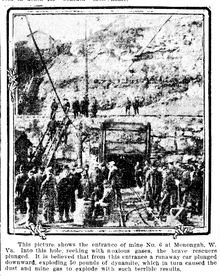
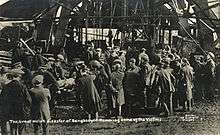
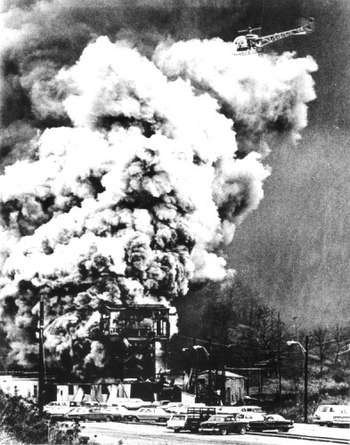
This is an incomplete list of notable mining accidents and disasters:
19th century
- 1872: Pelsall Hall Colliery disaster in Pelsall, West Midlands. 23 people died.
- 1885: Mardy Colliery in Rhondda Cynon Taf. 85 men and boys killed.
- June 17, 1890: Dunbar Furnace Company Hill Farm Mine in Connellsville, PA. 30 Miners died[6]
- Unknown date, 1890: Coalburg, Alabama Eleven killed.[7]
- 1892: Krebs Mine explosion in Krebs, Oklahoma. Nearly 100 died.[8]
- 1892: St Mary ore mine fire. Příbram, now Czech Republic, then Austria-Hungary, 319 died.
- July 4, 1893: Combs Colliery disaster in Thornhill, England, 139 men & boys died.[9]
- 1899: Sumitomo Besshi bronze mine area, landslide with debris flow disaster, Niihama, Shikoku, Japan, 512 died.
20th century
- 20 February 1905 Virginia City Mine explosion (Alabama), One hundred and twelve killed.[10]
- March 10, 1906: Courrières mine disaster in Courrières, France. 1,099 workers died in the worst mine accident in European history.
- December 1, 1907: Naomi Mine Explosion in Fayette City, PA. 34 workers died.
- December 6, 1907: Monongah Mining Disaster in Monongah, WV. Official death toll is 362, but due to inadequate record keeping, the true death toll could be around 500.[11] Victims were mostly Italian immigrants, including children. Considered the worst coal mining accident in American history.
- 16 December 1907: Yolande mine explosion. Fifty-seven killed.[12]
- December 19, 1907: Darr Mine Disaster in Rostraver Township, PA. 239 workers died, including children.
- November 13, 1909: Cherry Mine Disaster in Cherry, IL. 259 workers, some as young as eleven, died. The worst mine fire by deaths in America.
- December 21, 1910: The Pretoria Pit Disaster in Westhoughton, Lancashire, 344 men and boys lost their lives in an explosion which is the worst mining disaster on one day in England.
- April 8. 1911 Banner Mine disaster near Littleton, Alabama. Of the 128 killed, most were Black convicts.
- October 14, 1913: Senghenydd Colliery Disaster, the worst Mining accident in the United Kingdom; 439 workers died.
- October 22, 1913: Dawson Stag Canon Number 2 Mine Disaster, near Dawson, New Mexico,[13] where 263 workers were killed due to illegal use of dynamite.
- June 8, 1917: Speculator Mine Disaster in Butte, Montana. An electric cable being lowered into the mine was accidentally ignited at 2,500 meters below the surface. The fire quickly climbed the cable which ignited the mine's wooden shaft. The shaft thus became a chimney, eliminating the mine's primary source of oxygen. Nearly all of the 168 fatalities were due to asphyxia. It remains the deadliest underground hard rock mining event in American history.
- February 8, 1923 Dawson Stag Canon #1 Mine Explosion killed 123, many children of those killed in the explosion at the same mine in 1913. The explosion was due to a derailed mine car that caused sparks and ignited coal dust.
- 1927–1932: Hawks Nest Tunnel Disaster, near Gauley Bridge, West Virginia, United States. Over several years, 476 workers died from silicosis.
- April 26, 1942: Benxihu Colliery disaster in Benxi, Liaoning, China. 1,549 workers died, in the worst coal mine accident ever in the world.
- February 20, 1946: Monopol Grimberg III/IV disaster in Bergkamen, Ruhr Coalfield, Germany. 405 died.
- December 21, 1951: Orient 2 coal mine explosion in West Frankfort, Illinois. 119 workers died.
- December 10, 1954: Newton Chikli Colliery disaster, Chhindwara (M.P.), India. Flooding of the mine was caused by inrush of water from old workings of the same mine. There were 112 persons inside the mine when it was inundated. 49 persons managed to escape through the incline; the remaining 63 persons were trapped and drowned.
- August 8, 1956: Bois du Cazier disaster in Marcinelle, Belgium. A fire in the mines resulted in 262 casualties; of the 274 people working in Bois du Cazier on that morning, only twelve survived. 138 of the victims were Italian migrant workers.
- Jan 22, 1959: Knox Mine disaster at River Slope Mine, Port Griffith Luzerne County, Pennsylvania - flooding from the riverbed above works killed 12 miners[14]
- 1960: Coalbrook mining disaster, South Africa, 437 died.
- 9 May 1960: Laobaidong colliery coal dust explosion Datong, China, 682 died.
- 7 July 1961: Dukla Coal Mine, Dolní Suchá, Czechoslovakia, Fire and therefore poisoning caused death of 108 miners.
- 9 November 1963: Mitsui Miike Coal Mine disaster Mitsui Miike, Ōmuta, Fukuoka, Japan, 458 died.[15]
- May 28, 1965: Dhanbad coal mine disaster took place in Jharkhand, India, killing over 300 miners.
- May 17, 1965: Cambrian Colliery in South Wales, 31 died.
- October 21, 1966: Aberfan disaster was a catastrophic collapse of a colliery spoil-tip that occurred in the Welsh village of Aberfan, killing 116 children and 28 adults.
- November 20, 1968: Farmington Mine Disaster in Farmington, WV. 78 workers died. As a result of the disaster, the U.S. Congress passed the Federal Coal Mine Health and Safety Act of 1969.
- 1972: Wankie coal mine disaster Wankie, Rhodesia/Zimbabwe, 426 fatalities.
- 21 March 1973: Lofthouse Colliery disaster, West Yorkshire, England, seven fatalities.
- 27 December 1975: Chasnala mining disaster, Dhanbad, Jharkhand, India, 372 miners died and another 130 contract workers are claimed to have died when water from adjacent mine gusted after the wall in between collapsed.
- September 12, 1983: Mohd.Darabi Coal mine disaster took place near Shemiranat, Tehran, 14 people died.
- July 19, 1985: Val di Stava dam collapse took place in the village of Stava, near Tesero, Italy, when two tailings dams used for sedimenting the mud from the nearby Prestavel mine, failed. It resulted in one of Italy's worst disasters, killing 268 people, destroying 63 buildings and demolishing eight bridges.
- 16 September 1986 Kinross Mining disaster. In South Africa an underground fire killed 177 people.
- 2 June 1988 Borken, Hessen, Germany A lignite mine devastated by an explosion, 57 fatalities.
- May 9, 1992: Westray Mine, Pictou County, Nova Scotia. 26 killed in a methane and coal dust explosion.
- May 9, 1993: Nambija mine disaster, Nambija, Ecuador. Approximately 300 people were killed in a landslide
- August 28, 1994: Rajpura Dariba Mine VRM disaster, Dariba, Udaipur, India: This incident occurred due to flooding of the slurry from a mined VRM Underground mining (hard rock)#Mining methods stop where cemented fill could not settle and its plug failed. This slurry accumulated in the plugged shaft which could not take the load and subsequently failed. This created a sudden fall of the all of the material in the shaft, which resulted in the 63 people working below drowning.[16][17]
- 10 May 1995 Vaal Reefs, South Africa a locomotive fell down a lift shaft and landed on a cage causing the deaths of 104 people.
21st century
- January 30, 2000: Baia Mare cyanide spill took place in Baia Mare, Romania. The accident, called the worst environmental disaster in Europe since Chernobyl, was a release of 100,000 tons of cyanide contaminated water by an Aurul mining company due to reservoir broke into the rivers Someş, Tisza and Danube. Although no human fatalities were reported, the leak killed up to 80% of aquatic life of some of the affected rivers.
- February 19, 2006: Pasta de Conchos accident. 65 miners lost their lives in the mining accident near Nueva Rosita, Coahuila, Mexico. Only 2 bodies have been recovered.
- April 5, 2010: Upper Big Branch Mine disaster, West Virginia, United States. An explosion occurred in Massey Energy's Upper Big Branch coal. Twenty-nine out of thirty-one miners at the site were killed.[18]
- August 5, 2010: 2010 Copiapó mining accident, Atacama Desert, Chile. The 121-year-old San José copper–gold mine structurally collapsed at 14:05 CLT The heart of the mountain that has the mass of two Empire State Buildings collapsed leaving catastrophic damage to the mine and blocking all possible escape routes for the 33 miners trapped at 2300 feet. All 33 miners were rescued after 69 days of the Initial accident
- November 19, 2010: Pike River Mine disaster in New Zealand. At 3:45pm, the coal mine exploded. Twenty-nine men underground died immediately, or shortly afterwards, from the blast or from the toxic atmosphere. Two men in the stone drift, some distance from the mine workings, managed to escape. (Extract from Royal Commission of Enquiry Report on Pike River.)
- May 13, 2014: Soma mine disaster took place in Soma, Turkey. The accident, called the worst mining accident ever in Turkey, and it is the worst mining accident in the 21st century so far. 301 people died.
A total of 8447 deaths are listed above.
Accidents by country
Australia

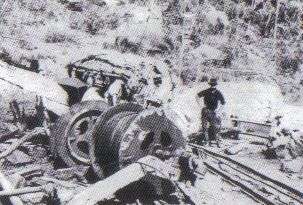
The Bulli Mine Disaster of 23 March 1887 involved a gas explosion in the mine that killed 81 men and boys, leaving 50 women widows and 150 children without fathers.
The Mount Kembla Mine Disaster of 31 July 1902 was an explosion resulting in the death of 96 miners, including two engaged in rescue work. It remains the worst mining disaster in Australian history.
A coal dust explosion at the Mount Mulligan mine on 19 September 1921 killed 75 or 76 workers.
Tasmania's Beaconsfield Mine collapse occurred on 25 April 2006. Of the 17 people who were in the mine at the time, 14 escaped immediately following the collapse, one was killed and the remaining two were found alive after five days. The survivors were trapped in a 1.5m x 1.2m cherry picker cage, which had saved them from being crushed by rocks.[19] As it was not safe for rescuers to blast their way through, a special borer was brought in to drill an escape shaft. They were finally released on 9 May after 14 days underground.
Three mining disasters occurred at Moura in a 20-year period. The first of these was in 1975, at the Kianga Mine, where 13 men died in an underground explosion. The mine was sealed without their bodies being retrieved. In 1986 a second disaster occurred, as an underground explosion, which took the lives of 12 miners. The bodies of all those persons were retrieved. In Moura on 7 August 1994 a third major mining accident occurred with an explosion at Moura No. 2 Mine. A second explosion at the mine approximately a day and a half later saw rescue attempts abandoned, and the mine was sealed, with the bodies of the 11 miners unretrieved.
In the 1996 Gretley coal mine disaster, near Newcastle, four men were killed when their mining machine broke into the flooded workings of an old coalmine, abandoned over 80 years earlier.[20][21]
Four miners were killed in a windblast incident at the Northparkes mine outside the New South Wales town of Parkes in 1999.[22]
Belgium
On March 4, 1887, 120 miners died in a coal mine in La Boule, Borinage due to a methane explosion.[23]
On the morning of August 8, 1956, a fire in the mine Bois du Cazier in Marcinelle caused 262 victims, with only 12 survivors.[24] A mining cart on an elevator cage hit an oil pipe and electricity lines, with the resulting fire trapping the miners. Most of the victims were immigrants (136 Italians, 8 Poles, 6 Greeks, 5 Germans, 5 Frenchmen, 3 Hungarians, 1 Englishman, 1 Dutchman, 1 Russian and 1 Ukrainian.[25])
Bosnia and Herzegovina
On September 4, 2014, after a 3.5 Richter earthquake hit Zenica caused rock burst in coal mine "Raspotočje", 34 miners remained trapped inside the mine. It was later reported that 5 miners were killed in the accident.[26]
Canada
The most well-known mining accidents in Canada have all occurred within the province of Nova Scotia. The most serious of them was a series of three coal mining disasters spanning 65 years referred to collectively as the Springhill mining disasters, which claimed in total at least 138 lives of men and boys due to coal dust explosions. The Westray Mine disaster in 1992 claimed the lives of 26 miners in a methane/coal dust explosion at a recently opened mining operation. Both of these mines were subsequently permanently closed in the wake of these events.
The 1887 Nanaimo mine explosion in Nanaimo, British Columbia killed 150 miners at the No 1 Esplanade Mine. Explosives were laid improperly triggering a massive mine-wide explosion. Most miners were killed instantly, only 7 survived. Of the 150 workers killed, 53 of them were Chinese, the names of which are mostly unknown.
The Hillcrest mine disaster, the worst coal mining disaster of Canadian history, occurred in Alberta in 1914. Deaths from the methane and coal dust-fueled explosion numbered 189; news coverage was eclipsed by the First World War. The mine remained in use until 1939.
Central African Republic
In June 2013, heavy rains provoked the collapse of a gold mine in Ndassima, killing 37 miners and injuring many others.[27]
Chile
In June 1945, during a fire, 355 workers died in El Teniente by inhaling carbon monoxide, in what was called the "Tragedia del Humo" (English: The Smoke Tragedy).
In January 2006, an explosion occurred in a mine in Copiapó, leaving 70 miners trapped underground. The miners were rescued after a brief period of time, but two people died.
In August 2010, 33 miners were trapped underground in Copiapó. After two weeks communication was made with them but it was said at least four more months would pass before they could be rescued, though essential services could still be provided. The rescues began on October 12, 2010 and all the 33 miners were rescued within 22 hours of first rescue. The world watched and cheered.[28]
China
According to one source, in 2003 China accounted for the largest number of coal-mining fatalities, accounting for about 80% of the world's total, although it produced only 35% of the world's coal.[29] Between January 2001 and October 2004, there were 188 accidents that had a death toll of more than 10, about one such accident every 7.4 days.[29] After the 2005 Sunjiawan mine disaster, which killed at least 210 miners, a meeting of the State Council was convened to work on measures to improve work safety in coal mines. The meeting's statement indicated serious problems such as violation of safety standards and overproduction in some coal mines. Three billion yuan (360 million US dollars) were dedicated for technological renovation on work safety, gas management in particular, at state-owned major coal mines. The government also promised to send safety supervision teams to 45 coal mines with serious gas problems and invite colliery safety experts to evaluate safety situations in coal mines and formulate prevention measures.[30]
In 2006, according to the State Work Safety Supervision Administration, 4,749 Chinese coal miners were killed in thousands of blasts, floods, and other accidents. For example, a gas explosion at the Nanshan Colliery killed 24 people on November 13, 2006; the mine was operating without any safety license and the Xinhua News Agency claimed the cause was incorrect usage of explosives. However, the 2006 rate was 20.1% less than 2005 despite an 8.1% increase in production.[31]
The New York Times reported that China's lack of a free press, independent trade unions, citizen watchdog groups and other checks of official power has made cover-ups of mining accidents more possible, even in the Internet age. As a result, Chinese bureaucrats habitually hide scandals (such as mine disasters, chemical spills, the 2003 SARS epidemic, and tainted milk powder) for fear of being held accountable by the ruling Communist Party or exposing their own illicit deals with companies involved. Under China's authoritarian system, superiors reward subordinates for strict compliance with goals established by authorities, like reducing mine disasters. Indeed, should a mining accident occur, the incentive to hide it is often stronger than the reward for managing it well, as any disaster is almost surely considered a liability.[32]
In November 2009, a mining accident in Heilongjiang killed at least 104 people. It is thought to have been caused by a methane explosion followed by a coal dust explosion. Three top officials involved with the mining company were promptly dismissed.
On August 30, 2012 an explosion killed 45 people at the Xiaojiawan coal mine in Sichuan province.[33][34] A few days later on September 3, 2012 14 miners were killed at Gaokeng Coal Mine in Jiangxi province.[35]
On March 29, 2013, a landslide trapped 83 people in the Gyama Mine in Tibet.[36]
On 4 January 2014 The Chinese Government stated that 1,049 people died in the year 2013, down 24 percent from 2012.[37]
Ecuador
About 300 people were killed on May 9, 1993 in the Nambija mine disaster in Ecuador.[38]
On October 15, 2010, shortly after Chile completed its historic, successful rescue of 33 miners who had been stuck underground in the San Jose mine for a record period of nearly 10 weeks, four workers were trapped in an Ecuadoran gold mine following a tunnel collapse. All were confirmed dead by October 20.[39]
France
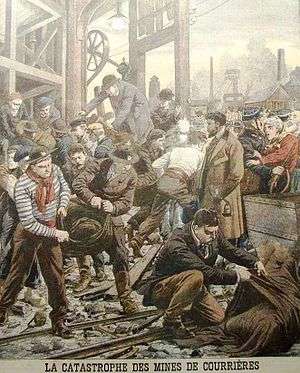
The Courrières mine disaster was the worst ever pit mine disaster in Europe. It caused the death of 1,099 miners (including many children) in Northern France on 10 March 1906. It seems that this disaster was surpassed only by the Benxihu Colliery accident in China on April 26, 1942, which killed 1,549 miners. A dust explosion, the cause of which is not known with certainty, devastated a coal mine operated by the Compagnie des mines de houille de Courrières (founded in 1852) between the villages of Méricourt (404 killed), Sallaumines (304 killed), Billy-Montigny (114 killed), and Noyelles-sous-Lens (102 killed) about two kilometres (one mile) to the east of Lens, in the Pas-de-Calais département (about 220 km, or 140 miles, north of Paris).
A large explosion was heard shortly after 06:30 on the morning of Saturday 10 March 1906. An elevator cage at Shaft 3 was thrown to the surface, damaging pit-head workings; windows and roofs were blown out on the surface at Shaft 4; an elevator cage raised at Shaft 2 contained only dead and unconscious miners.
India
- Burra Dhemo Colliery on 26.9.1956
- Central Bhowrah Colliery on 20.2.1958
- Central Saunda Colliery on 16.9.1976
- Central Saunda Colliery on 15.06.2005
- Chasnalla Colliery on 27.12.1975
- Damua Colliery on 5.1.1960
- Gaslitand Colliery on 26 or 27.9.1995
- Godavarkhani No. 7 LEP on 16.06.2003
- Hurriladih Colliery on 14.9.1983
- Jotejanaki Colliery on 28.6.1913
- Loyabad Colliery on 16.1.1935
- Mahabir Colliery on 13.11.1989
- Majri Colliery on 5.8.1953
- Makerwal Colliery on 6.7.1942
- Newton Chikli Colliery on 10.12.1954
- Phularitand Colliery on 11.07.1912
- Rajpura Dariba Mine VRM disaster on 28.8.1994
- Silewara Colliery on 18.11.1975[40]
Japan
Mine disaster of a number occurs from the 1900s to 1980s in Japan, with introduce only large-scale disaster.[41]
- Hokkaido
- New Yubari Coal Mine accident, November 1914, 423 fatalities.
- Hokutan Yubari,
- April 1912 accident, 276 fatalities.
- December 1912 accident, 216 fatalities.
- December 1938 accident, 161 fatalities.
- October 1981 accident 93 fatalities.
- South Yubari Coal mine accident, May 1985, 62 fatalities.
- Bibai coal mine
- March 1941 accident, 177 fatalities.
- May 1944 accident, 109 fatalities.
- Honshu
- Uchigo coal mine caught fire accident in March 1927, 134 fatalities in Iwaki, Fukushima Prefecture
- East Mizome coal mine seawater inflow accident in April 1915, 235 fatalities in Ube, Yamaguchi Prefecture
- Chosei coal mine submerged cave accident in February 1942, 183 fatalities in Ube.
- Kyushu
- Hojo coal mine explosion in December 1914, 687 fatalities in Miyata, Fukuoka.
- Hokoku coal mine accidents in Itoda, Fukuoka Prefecture.
- June 1899 accident, 213 fatalities.
- July 1907 accident, 365 fatalities.
- Onoura coal mine accidents in Miyata, Fukuoka Prefecture.
- November 1909 accident, 243 fatalities.
- December 1918 accident, 376 fatalities.
- January 1939 accident, 94 fatalities.
- 1965 Yamano coal mine accident on June in Maka, Fukuoka, 237 fatalities.
- 1906 Takashima coal mine explosion on March, 307 fatalities in Nagasaki
- 1963 Mikawa coal mine accident on November in Fukuoka, 458 fatalities.
Netherlands
The twelve mines in the Netherlands, four of which were state owned, were considered among the safest in the world, with only three larger accidents occurring during 70 years of mining:
-On 13 July 1928 a methane gas explosion killed 13 miners in the state-owned mine Hendrik in Brunssum.
-On 24 March 1947 13 miners from Staatsmijn Hendrik were killed in a fire caused by an overheated conveyor belt.
-On 3 March 1958 7 miners lost their lives when a cave-in occurred at Staatsmijn Maurits in Geleen.
New Zealand
The most notable mining accident in New Zealand is the 1896 Brunner Mine disaster, which killed all 65 miners inside. On 19 November 2010, there were four explosions over nine days at Pike River mine; 29 miners were killed and two escaped with minor injuries.
On 19 January 1967, there was an explosion in the Strongman Mine, near Greymouth, on the West Coast. 19 people were killed.[42]
Poland
On November 25, 2006, the worst mining disaster occurred in modern Polish history, 23 miners lost their lives at Halemba Coal Mine, a colliery in the town of Ruda Slaska in the southern industrial province of Silesia. A methane explosion at a depth of 1,030 meters caused the November 21 tragedy. The miners were attempting to retrieve €17 million ($US22 million) worth of equipment from a tunnel when a blast caused the shaft to collapse. The tunnel was supposed to have been closed in March due to dangerously high methane concentrations, but was kept active because of the value of the equipment left behind.[43]
Russia
Several major mining accidents have happened in Russia, particularly the Ulyanovskaya Mine disaster of 2007, which killed at least 106 miners. On January 20, 2013, at least four miners have died and four more are missing following an accident at a Russian coal mine. The accident happened at a coal mine in the Kuznetsk Basin region of Russia, in western Siberia.[44]
South Africa
A number of major mining accidents happened in South Africa including the following accidents:
- 437 deaths[45] on 21 January 1960 the Coalbrook mining disaster occurred at Coalbrook North colliery. Coalbrook North colliery was one of the underground collieries of Clydesdale (Transvaal) Collieries Limited and was situated near Sasolburg in the Orange Free State province[46][47]
- 177 killed on 16 September 1986 at the Kinross gold mine in Evander, Mpumalanga. This is still the world's worst metal mining disaster.
- 104 deaths on 10 May 1995 at Vaal Reefs number two shaft near Orkney, in the North West, was arguably one of the worst to befall mining in South Africa.
- 64 deaths on 12 September 1983 at Hlobane Colliery near Vryheid, Kwa-Zulu Natal
- 57 deaths on 12 September 1944 at Hlobane Colliery near Vryheid, Kwa-Zulu Natal[48]
- 53 deaths on 13 May 1993 at Middelbult colliery. Middelbult colliery was and is still one of the underground collieries of Sasol Mining situated near the town of Secunda, Mpumalanga
Taiwan
The three worst mining accidents in Taiwan all happened in 1984:
- On June 20, 1984, in Haishan Coal Mine in Tucheng District, a runaway mining cart struck a high voltage transformer and triggered an explosion. 72 miners died from carbon monoxide poisoning.[49]
- On July 10, 1984, 103 miners died in Meishan Coal Mine in Ruifang District as a result of carbon monoxide poisoning caused by a fire started in the air compressor chamber.[50]
- On December 5, 1984, an explosion occurred at Haishan Coal Mine No. 1 in Sanxia District. 93 miners died from carbon monoxide poisoning with only one survival who was rescued 93 hours after the initial explosion.
Tanzania
At least 56 miners were killed in April 1998 after heavy rains flooded tanzanite mine shafts.[51] Five people were killed in July 2013 after the tanzanite quarry they were working in the Mererani mining hills collapsed above their heads. A sixth was admitted to hospital in critical condition.[52]
Turkey
In March 1983, in the Armutçuk coal mine 103 miners died due to a methane gas explosion.[53]
In March 1992 at the TCC Kozla mine, 263 miners were killed due to a firedamp explosion[54]
In 2008 there was another disaster which resulted in one person losing their life. In November 2013, 300 workers barricaded the Zonguldak mine in order to protest the working conditions.
During the year of 2009, in December killed 19 miners due to a methane gas explosion in Bursa Province.
In 2010, there was a mining disaster in Zonguldak Province which resulted in the deaths of 30 workers in a coal mine. The explosion was caused by a firedamp explosion. Previous mining disasters have also occurred here, one in 1992 resulted in the deaths of 270 workers. This was the worst mining disaster until the Soma mine disaster.
In May 2014, in Soma, Manisa there was a major mine collapse caused by an explosion. More than 302 workers lost their lives in the collapse and at least 80 workers were injured.[55][56][57][58]
Unfortunately, in recent years the Turkish coal mining industry has been found to have the very worst safety record in the world, in terms of fatal accidents per million tons of coal produced. When using the "deaths per million tons of coal production" measure, on any given day, a Turkish coal miner is 360 times more likely to be killed in a Turkish mine than an American coal miner is in an American mine, and 5 times more likely to die from the lax mine safety standards of the Turkish mines than even a Chinese coal miner, whose country places with a distant second in terms of safety related deaths per million tons of coal produced.[59]
United Kingdom
England
In England, The Oaks explosion remains overall the worst mining accident, claiming 388 lives on 12–13 December 1866 near Barnsley in Yorkshire although in the first and main explosion on 340 died, less than at the Hulton colliery but subsequent explosions claimed other lives during the night and the following day. The Hulton Colliery explosion at Westhoughton, Lancashire, in 1910 claimed the lives of 344 miners.[60] An explosion in 1878, at the Wood Pit, Haydock, Lancashire, killed over 200 workers, although only 189 were included in the 'official list'.[61] Another disaster that killed many miners was the Hartley Colliery Disaster, which occurred in January 1862 when the beam of the pumping engine broke suddenly and fell into the single shaft serving the pit. It blocked the shaft, and entombed hundreds of miners. The final death toll was 204, most of whom were suffocated by the lack of oxygen in the mine atmosphere.
In the metalliferous mines of Cornwall, some of the worst accidents were at East Wheal Rose in 1846, where 39 workers were killed by a sudden flood; at Levant mine in 1919, where 31 were killed and many injured in a failure of the man engine;[62] 12 killed at Wheal Agar in 1883 when a cage fell down a shaft;[63] and seven killed at Dolcoath mine in 1893 when a large stull collapsed.[64]
Scotland
The worst mining accident in Scotland is the 1877 Blantyre mining disaster in Blantyre, Lanarkshire, which claimed 207 lives. Other fatal incidents occurred in the town in 1878 and 1879.[65]
Another serious incident occurred in the small Ayrshire mining village of Knockshinnoch in September 1950. For several tense days rescuers battled bravely against all odds to reach the 129 men trapped deep underground when a field above where they were working caved-in, flooding the mine workings with thick liquid peat, cutting off all means of escape. 116 were rescued but 13 died.[66] A film, The Brave Don't Cry was made about the distaster in 1952.[67]
Wales
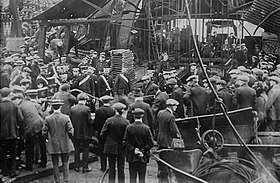
During the period 1850 to 1930 the South Wales coalfield had the worst disaster record. This was due to the increasing number of mines being sunk to greater depths into gas-containing strata, combined with poor safety and management practices. As a result, there were nearly forty underground explosions in the Glamorgan and Monmouthshire areas of the coalfield during this time. Each accident resulted in the deaths of twenty or more workers - either directly in the explosion or by suffocation by the poisonous gases formed. The total death toll from these disasters was 3,119 people. The four worst accidents in Wales were:
- 439 deaths at the Senghenydd Colliery Disaster at Universal Colliery in Senghenydd, Glamorgan, in a gas explosion in 1913.
- 290 deaths at the Albion Colliery in Cilfynydd, Glamorgan, in a gas explosion on 25 June 1894.
- 272 deaths at the Prince of Wales Colliery, Abercarn, Monmouthshire, in an explosion of 11 September 1878.[68]
- 266 deaths in the Gresford Disaster near Wrexham in North Wales on 22 September 1934.
Some collieries, e.g. Morfa Colliery,[69] near Port Talbot, Glamorgan, and Black Vein Colliery, Risca, Monmouthshire, suffered three disasters before they were closed for being unsafe.
United States
The Scofield Mine disaster was a mining accident on May 1, 1900 in which at least 200 workers died.
The Monongah Mining Disaster was the worst mining accident of American history; 362 workers were killed in an underground explosion on December 6, 1907 in Monongah, West Virginia.
The First Dawson Disasters was a mining accident on October 22, 1913 in Dawson, New Mexico in which 263 men died (146 were Italian and 36 were Greek).
The Second Dawson Disasters was a mining accident on February 8, 1923 in Dawson, New Mexico in which 123 men died.
The Speculator Mine Disaster occurred in the copper mines of Butte, Montana on June 8, 1917. An electric cable being lowered into the mine was accidentally ignited at 2,500 meters below the surface. The fire quickly climbed the cable, in turn igniting the shaft. The shaft thus became a chimney, eliminating the mine's primary source of oxygen. Nearly all of the 168 fatalities were due to asphyxia. It remains the deadliest underground hard rock mining event in American history.
The Cherry Mine disaster was a fire in the Cherry, Illinois, coal mine in 1909, and surrounding events, in which 259 men and boys died.
The Millfield Mine Disaster 1930 in Ohio killed 82 men.
From 1880 to 1910, mine accidents claimed thousands of fatalities. Where annual mining deaths had numbered more than 1,000 a year during the early part of the 20th century, they decreased to an average of about 500 during the late 1950s, and to 93 during the 1990s.[70] In addition to deaths, many thousands more are injured (an average of 21,351 injuries per year between 1991 and 1999), but overall there has been a downward trend of deaths and injuries.
In 1959, the Knox Mine Disaster occurred in Port Griffith, Pennsylvania. The swelling Susquehanna River collapsed into a mine under it and resulted in 12 deaths. In Plymouth, Pennsylvania, the Avondale Mine Disaster of 1869 resulted in the deaths of 108 miners and two rescue workers after a fire in the only shaft eliminated the oxygen in the mine. Federal laws for mining safety resulted from this disaster. Pennsylvania suffered another disaster in 2002 at Quecreek, 9 miners were trapped underground and subsequently rescued after 78 hours. During 2006, 72 miners lost their lives at work, 47 by coal mining. The majority of these fatalities occurred in Kentucky and West Virginia, including the Sago Mine Disaster.[71][72] On April 5, 2010, in the Upper Big Branch Mine disaster an underground explosion caused the deaths of 29 miners.
The U.S. Bureau of Mines was created in 1910 to investigate accidents, advise industry, conduct production and safety research, and teach courses in accident prevention, first aid, and mine rescue. The Federal Coal Mine Health and Safety Acts of 1969 and 1977 set further safety standards for the mining. Since the closure of the U.S. Bureau of Mines in 1996, this research function has been carried on by the National Institute for Occupational Safety and Health.
Zimbabwe
The Kamandama mine disaster - Hwange in June 1972 was one of the worst ever mining disasters with 426 fatalities.
References
- ↑ Kucuker H. "Occupational fatalities among coal mine workers in Zonguldak, Turkey, 1994–2003". Occup Med (Lond) 2006 Mar;56(2):144-6. PMID 16490795
- ↑ Terazawa K, Takatori T, Tomii S, Nakano K. Methane asphyxia. Coal mine accident investigation of distribution of gas. Am J Forensic Med Pathol. 1985 Sep;6(3):211-4. PMID 3870672
- ↑ Retzer, John. "Ten Worst Mining Disasters". Michigan, USA: Bogey Media. Archived from the original on 18 April 2010. Retrieved 17 May 2014.
- ↑ "The world's worst coal mining disasters". Retrieved 16 August 2015.
- ↑ "Chinazhaoge Blog" (in Chinese). sohu.com. Retrieved 7 August 2010.
- ↑ Pittsburgh Post Gazette July 3,1960 page 3 section 1
- ↑ Flynt, Wayne (February 5, 2016). Poor But Proud. 2843: University of Alabama Press.
|access-date=requires|url=(help) - ↑ History.com. "Mine explodes in Oklahoma". History.com. A+E Networks. Retrieved 10 February 2016.
- ↑ http://www.dmm.org.uk/uknames/u1893-03.htm
- ↑ Flynt, Wayne (February 5, 2016). Poor But Proud. 2875: University of Alabama Press.
|access-date=requires|url=(help) - ↑ McAteer, Davitt (December 6, 2007). Monongah: The Tragic Story of the 1907 Monongah Mine Disaster, the Worst Industrial Accident in US History. West Virginia University Press. p. 332. ISBN 1-933202-29-7.
- ↑ Flynt, Wayne (February 5, 2016). Poor But Proud. 2880: University of Alabama Press.
|access-date=requires|url=(help) - ↑ Dawson, New Mexico
- ↑ Find a grave memorial
- ↑ Kawabata, Tai, "Film mines rich seams of history", Japan Times, 14 August 2011, p. 8.
- ↑ ; ismenvis.nic.in/Database/Rajpur_Dariba_Mine_2881994
- ↑ ; inundations/rajpura-dariba-mine-on-28-8-1994
- ↑ Urbina, Ian (9 April 2010). "The New York Times". nytimes.com. Retrieved 2014-01-28.
- ↑ Beaconsfield Mine Collapse, http://www.angelofoz.com/beaconsfield_miners_2006/index.htm
- ↑ "Charges laid over Gretley coal mine disaster" ABC news 12/8/2003. Accessed 21/3/2014
- ↑ "Mine found guilty over Gretley disaster" The Sydney Morning Herald 9/8/2004. 21/3/2014
- ↑ "PM - North Parkes mine disaster". abc.net.au. 1999-11-25. Retrieved 2014-01-28.
- ↑ http://maz-ale-01.mazenod.wa.edu.au/groups/1en1a/revisions/ff597/2/%5Bpermanent+dead+link%5D
- ↑ Description of the mine
- ↑ Emporis News Archived 2006-11-11 at the Wayback Machine.
- ↑ Varandani, Suman (5 September 2014). "Bosnia Mine Accident: 34 Coal Miners Trapped After Gas Explosion From Minor Earthquake". International Business Times. Retrieved 5 September 2014.
- ↑ At least 37 dead as Central African Republic gold mine collapses, International: Reuters, 24 June 2013
- ↑ Elaine Scott (2012). Buried Alive!: How 33 Miners Survived 69 Days Deep Under the Chilean Desert. Houghton Mifflin Harcourt.
- 1 2 Coal mining: Most deadly job in China Zhao Xiaohui & Jiang Xueli, Xinhua News Agency, Updated: 2004-11-13 15:01
- ↑ China takes steps to halt coal mine disasters Embassy of the People's Republic of China in the U.S.A., 02 February 2005
- ↑ China sees coal mine deaths fall, but outlook grim 11 January 2007, Reuters
- ↑ Lafraniere, Sharon (2009-04-11). "Graft in China Covers Up Toll of Coal Mines". The New York Times. Retrieved 2010-05-12.
- ↑ "China coal mine gas explosion kills 19 miners and traps dozens". The Guardian. London. 2012-08-30. Retrieved 2012-09-03.
- ↑ "Sichuan coal mine blast death toll rises to 43". Xinhuanet news. 2012-09-01. Retrieved 2012-09-03.
- ↑ "14 killed in Chinese coal mine blast". The Independent. London. 2012-09-03. Retrieved 2012-09-03.
- ↑ "Tibet mine landslide: Rescue workers recover more bodies". BBC News. 1 April 2013. Retrieved 2014-01-28.
- ↑ "International News | World News - ABC News". abcnews.go.com. Retrieved 2014-01-28.
- ↑ retrieved from http://www.france24.com/en/20101017-death-toll-rises-three-ecuador-mining-accident-quito
- ↑ retrieved from http://www.utsandiego.com/news/2010/Oct/20/last-of-4-missing-miners-found-dead-in-ecuador/
- ↑ ; mining-accidents-analysis, India
- ↑ 炭鉱(Japanese))
- ↑ retrieved from http://christchurchcitylibraries.com/kids/nzdisasters/strongman.asp
- ↑ retrieved from https://www.wsws.org/en/articles/2006/11/mine-n25.html
- ↑ retrieved from https://www.bbc.co.uk/news/world-europe-21108531
- ↑ "The Fourth Decade". Retrieved 21 July 2015.
- ↑ South Africa Delayed reaction : Time magazine 22 February 1960 - http://www.time.com/time/magazine/article/0,9171,939600,00.html
- ↑ Eskom annual reports 1959: "Archived copy" (PDF). Archived from the original (PDF) on 2012-03-30. Retrieved 2011-09-09.
- ↑ Hlobane disasters : "Archived copy" (PDF). Archived from the original (PDF) on 2012-03-25. Retrieved 2011-09-09.
- ↑ zh:海山煤礦
- ↑ zh:台灣煤礦
- ↑ "Over 50 dead in Tanzanian mining disaster". BBC. April 14, 1998.
- ↑ Five Killed in Mererani As Mining Pit Collapses, Africa: AllAfrica.com, 2013
- ↑ Logan, Nick (14 May 2014). "Turkey's worst mining disaster the latest in a string of deadly accidents". GlobalTv. Toronto, Ontario, Canada: Shaw Media. Retrieved 18 May 2014.
- ↑ "Mining Deaths in Germany vs: Turkey" (in Turkish). Istanbul: Istanbul Posta Gazette. 14 May 2014. Retrieved 18 May 2014.
- ↑ "Turkish mine disaster: Unions calls protest strike". BBC. 15 May 2014. Retrieved 15 May 2014.
- ↑ "Thousands strike over Turkish mine disaster". Retrieved 16 August 2015.
- ↑ "Death toll in Turkish mine disaster unlikely to exceed 302: minister". Reuters. Retrieved 16 August 2015.
- ↑ https://www.nytimes.com/2014/05/17/world/europe/turkish-authorities-say-miners-still-missing.html?_r=0
- ↑ Schleifer, Yigal (14 May 2014). "Turkey: Mine Tragedy Shines Light on Workplace Safety Concerns". The Turko-File. New York, New York, USA: EurasiaNet. Retrieved 18 May 2014.
- ↑ "Pretoria Pit Disaster". bolton.org.uk. Retrieved 2014-01-28.
- ↑ "GENUKI: Haydock, Lancashire genealogy". genuki.org.uk. Retrieved 2014-01-28.
- ↑ Corin, John (1992). Levant, A Champion Cornish Mine. The Trevithick Society. pp. 40–44. ISBN 0-904040-37-2.
- ↑ Vivian, John (1970). "The Wheal Agar Skip Disaster". Tales of the Cornish Miners. St. Austell: H. E. Warne Ltd. pp. 22–24.
- ↑ Vivian, John (1970). "When the Bottom of Dolcoath Fell In". Tales of the Cornish Miners. St. Austell: H. E. Warne Ltd. pp. 38–40.
- ↑ "Blantyre Mining Disaster". National Mining Museum Scotland. Retrieved 15 April 2017.
- ↑ "Knockshinnoch Colliery Disaster, Scotland, 1950 | MINING.com Video". infomine.com. Retrieved 2014-04-03.
- ↑ "The Brave Don't Cry (1952) - BFI". BFI. Retrieved 30 July 2015.
- ↑ Abercarn Colliery at welshcoalmines.co.uk
- ↑ "Morfa Colliery Port Talbot". welshcoalmines.co.uk. Retrieved 2014-01-28.
- ↑ Historical Data on Mine Disasters in the United States U.S. Department of Labor
- ↑ All Mining Fatalities By State Archived 2007-04-18 at the Wayback Machine. U.S. Department of Labor, Mine Safety and Health Administration, 15 January 2007
- ↑ Coal Fatalities By State Archived 2007-02-21 at the Wayback Machine. U.S. Department of Labor, Mine Safety and Health Administration, 15 January 2007
Further reading
- North of England Institute of Mining and Mechanical Engineers. Nicholas Wood Memorial Library "Mining accidents and safety: a guide to resources". 2016. A guide to books, journals, inspectors' reports, government enquiries, legislation, archival material, etc. in the Institute Library relating to accidents and safety in the UK.
- For more details of mining disasters in the UK see The Coalmining History Research Centre at https://web.archive.org/web/20160304103832/http://www.cmhrc.co.uk/site/database/result/39418.html